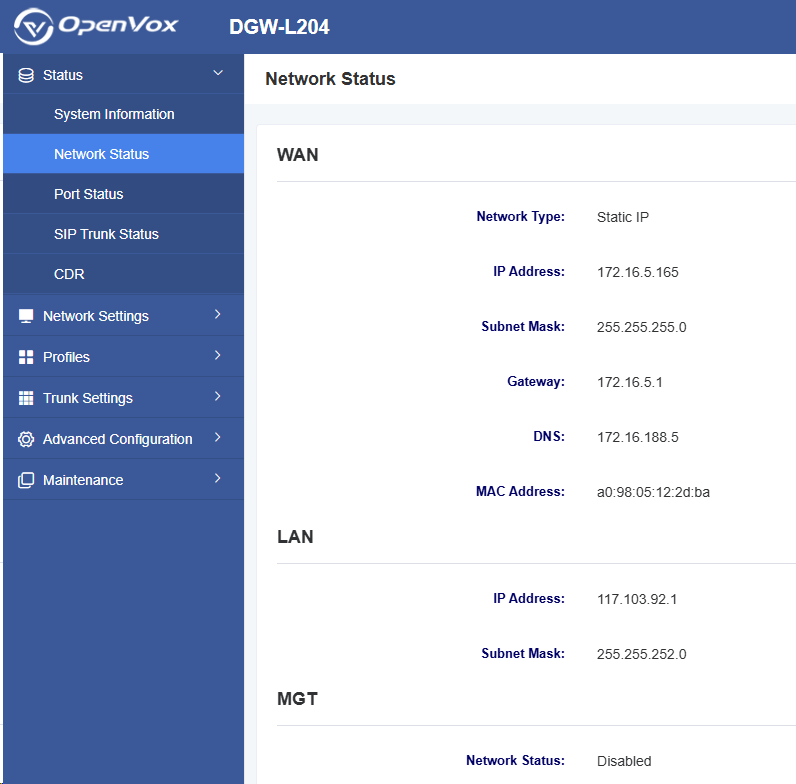Digital Gateway L20X User Manual
L20X Digital Gateway User Guide
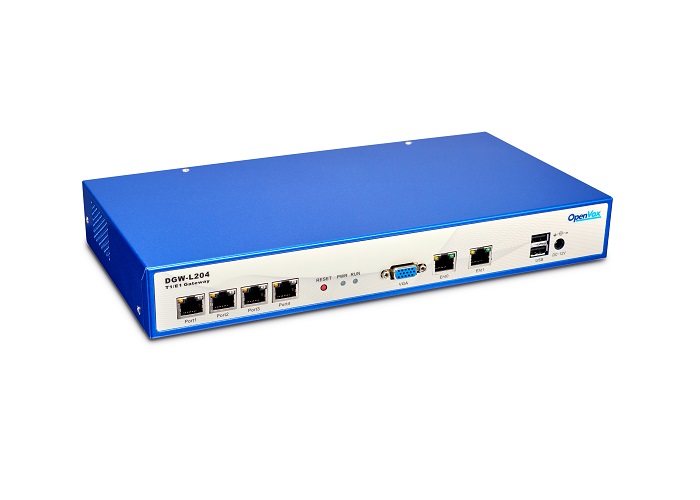
1 Overview
1.1 Product Description
The OpenVox DGW-L20X Gateway is an E1/T1 digital VolP Gateway that allows digital PSTN and ISDN hubs to be connected to a VolP network. It is a converged media product. The gateway realizes seamless connection between traditional telephone systems and IP networks, and seamless integration of VoIP PBX and ISDN. With the user-friendly GU1, users can easily set up their customized gateway. In addition, a second development can be accomplished via AMI (Asterisk Management Interface). The DGW-L20X T1/E1 Gateway supports 1/2/4 software-selectable T1/E1/PRI outlets for up to 120 concurrent calls.
1.2 Simple Usage
Figure 1-2-1 shows the simple use of the digital gateway column.
Figure 1-2-1 Application Topology Diagram
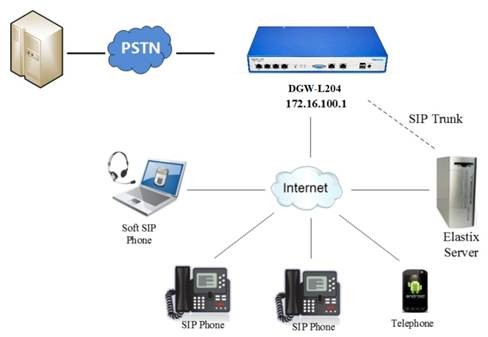
1.3 Product Appearance
Figure 1-3-1 Product Appearance
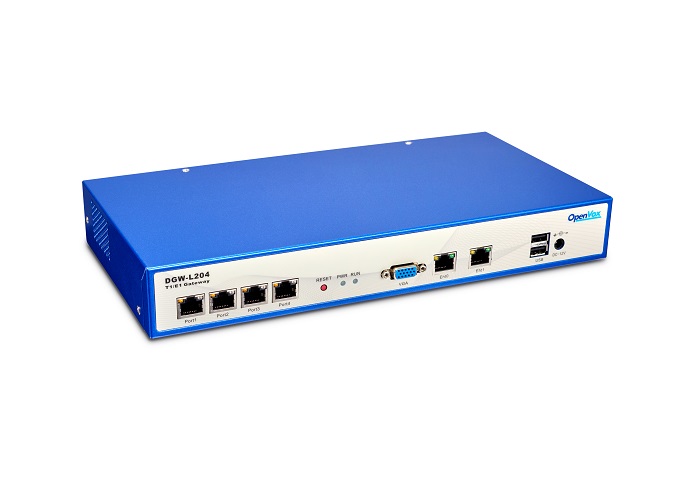
Figure 1-3-2 Front Panel
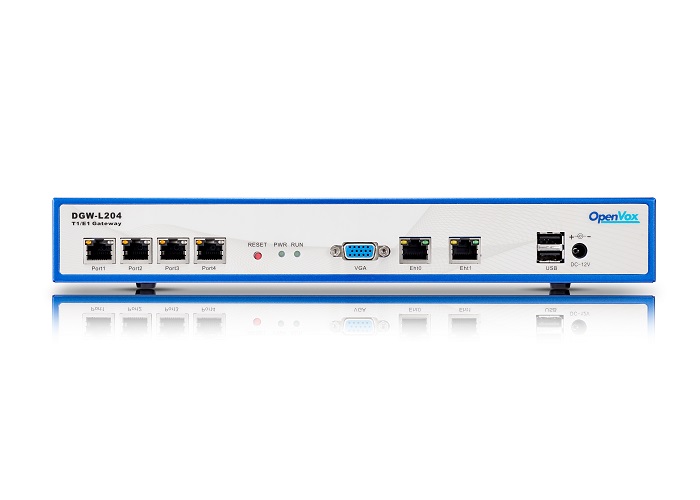 1
1
Figure 1-3-3 Back Panel
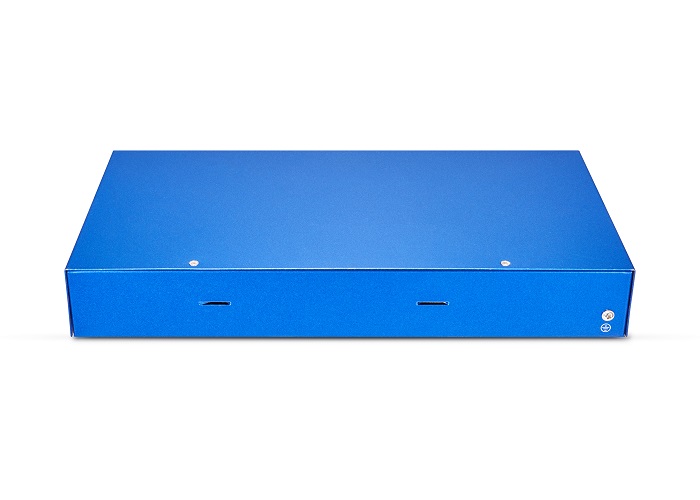
1.4 Software
| L20X | |
| Phone Port | 1/2/4 E1/T1 Ports |
| Profiles | Four profiles |
| Voice Compression | G.711A/U,G.723.1,G.729A/B, iLBC, OPUS, ARM and ARM-WB |
| Fax | T.38 complies with Class III fax relays up to 14.4 kpbs and automatically converts to G.711 for fax transmission.
T.38 fax relay uses V.17, V.21, V27ter, and V29 fax data pumps. |
| QoS | Diffserve, ToS, 802.1 P/Q VLAN tagging |
| Phone Features | Calling number display or blocking, call waiting, blind and advisory transfer, call forwarding, do not disturb, callback, paging, message waiting indicator and interval beep, auto dialing, flexible dialing rules |
| DTMF method
DTMF method |
Flexible DTMF transmission method, use of audio interface, RFC2833, and/or SIP Info. |
| SIP signaling | SIP (RFC 3261) over UDP/TCP/TLS |
| Security | SRTP/TLS/SIPS, HTTPS, 802.1x |
| Upgrade and Deployment | TFTP, HTTP, HTTPS |
| Web Protocols | TCP/UDP, RTP/RTCP, HTTP/HTTPS, ARP, ICMP, DNS, DHCP, NTP, TFTP, PPPoE, STUN |
1.5 Hardware Features
| L20X | |
| Port Type | RJ45 |
| Weight | 1352g |
| Size | 310mm*162.50mm*44mm |
| Power Supply | 12V 1A |
| Maximum Power | 18W |
| Operating Temperature Range | 0°C ~ 50°C |
| Storage Environment Humidity Range | 10% to 90% non-condensing |
| Storage Environment Temperature Range | -20°C to 70°C |
1.6 Software Features
Default IP: 192.168.6.65
Username: admin
Password: admin
Connect the network cable to LAN1/LAN2, enter the default IP address in the browser, and access the network settings to configure.
Note: The default network mode for this product is bridge mode. Regardless of whether the network cable is connected to the WAN port or LAN port, the IP address remains the same.
Figure 1-6-1 Login Interface
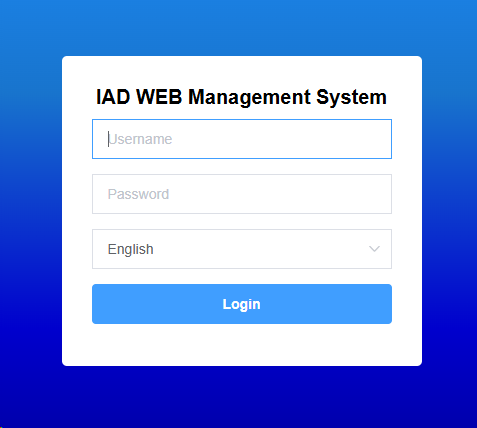
2 Status
2.1 System Status
The “System Status” page displays product information, firmware information, system time, and resource usage.
Figure 2-1-1 System Status Display
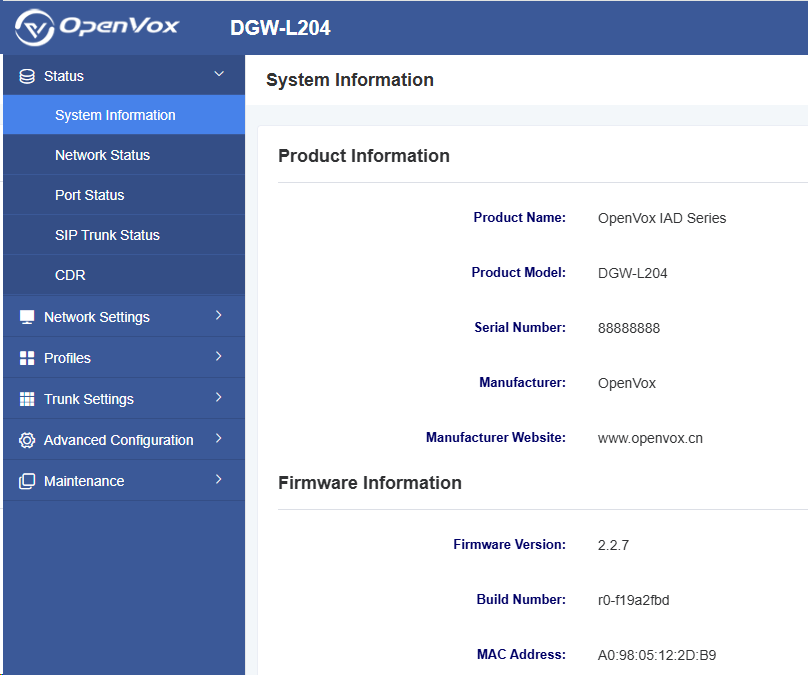
2.2 Network Status
The “Network Status” page displays network status and VPN connection status.
Figure 2-2-1 Network Status
2.3 Port Status
Figure 2-3-1 Port Status

The “Port Status” page displays port status and channel status.
2.4 SIP Trunk Status
On the SIP Trunk Status page, you can view the SIP trunk number, SIP signaling port, SIP user ID, authentication ID, registration status, IP direct routing table, and registration status.
Figure 2-4-1 SIP Trunk Status Page

2.5 CDR
On the CDR page, users can configure CDR settings and perform CDR queries.
Figure 2-5-1 CDR
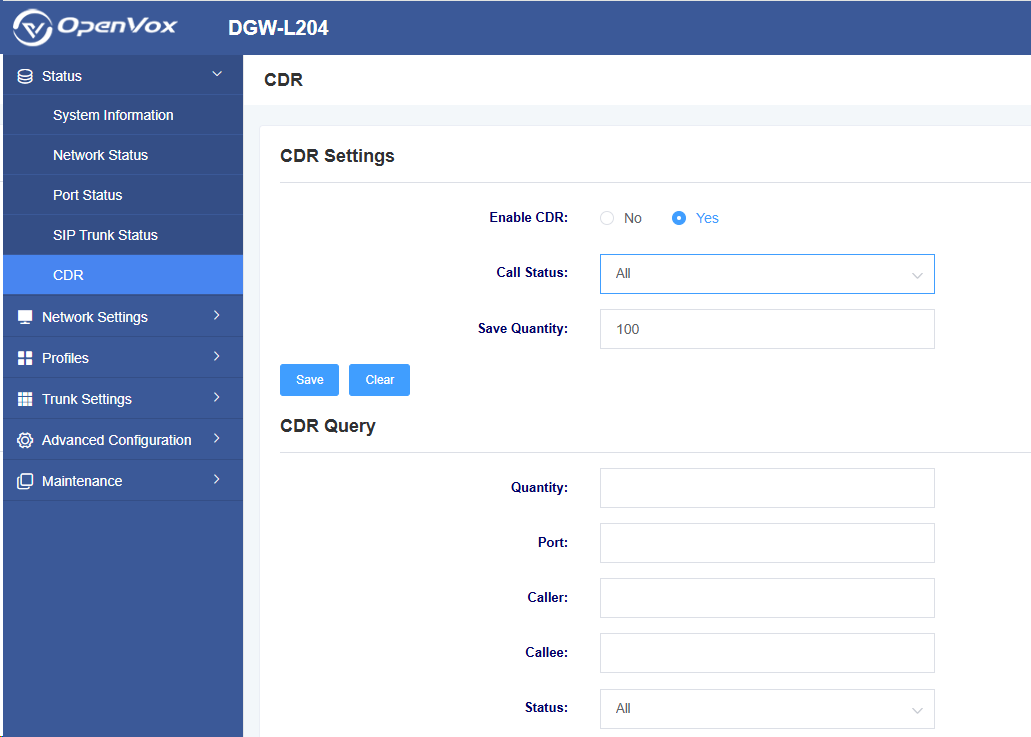
Note: CDR is only stored in memory and will be cleared upon reboot.
Table 2-5-1 CDR Options
| Option | Description |
| Enable CDR | This option selects whether to enable CDR |
| Call Status | Select the call status saved by CDR |
| Save Quantity | Set the number of CDR records to save |
| Quantity | Select the number of CDR records to query |
| Port | Select the port for CDR queries |
| Caller | Filter CDR query items by caller number |
| Callee | Filter CDR query items by callee number |
3 Network Settings
3.1 Local Network
Figure 3-1-1 Local Network Interface
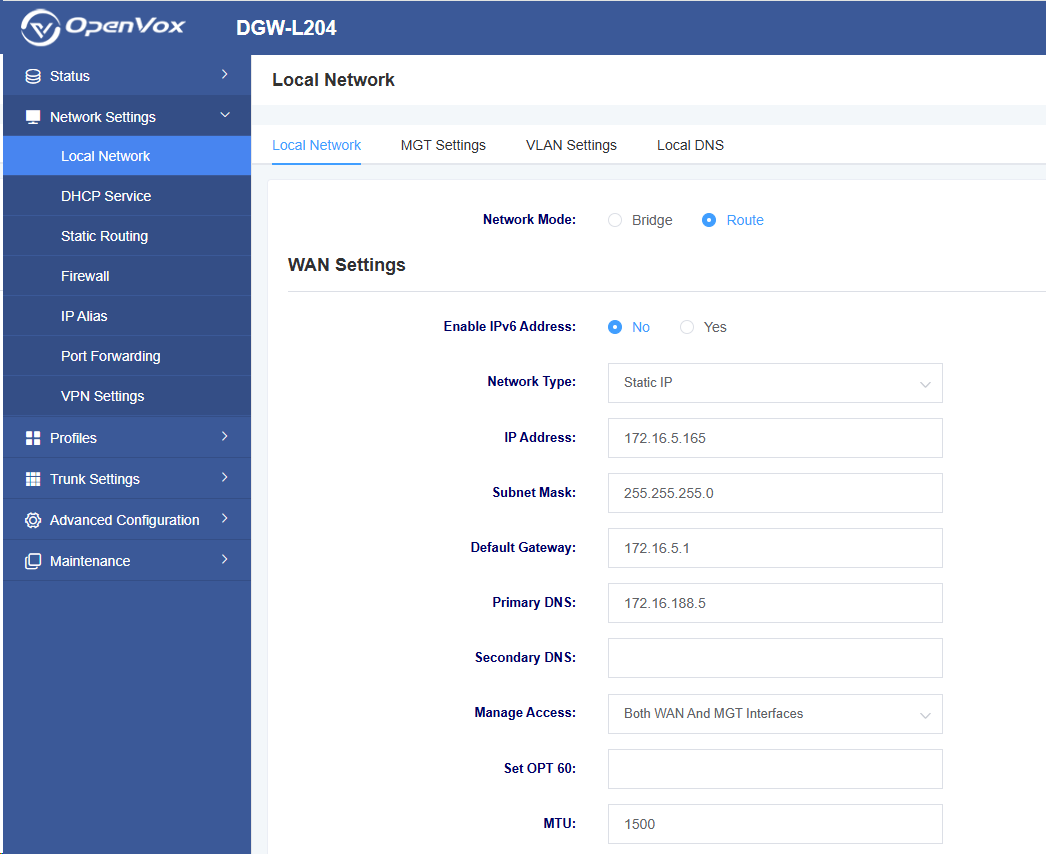
Table 3-1-1 WAN Settings Interface Parameter Description
| Option | Description |
| Network Mode | Select the device network mode |
| Network Type | Select the network type: DHCP, Static IP, PPPoE |
| IP Address | Set the device’s IP address |
| Subnet Mask | Set the device’s subnet mask |
| Default Gateway | Set the device’s default gateway |
| Option | Description |
| Primary DNS | Set the device’s primary DNS |
| Secondary DNS | Set the device’s secondary DNS |
| Management Access Options | Set web login restrictions |
| Set OPT 60 | Set OPT 60 |
| Options | Description |
| IP Address | Set the LAN port’s IP address |
| Subnet Mask | Set the LAN port’s subnet mask |
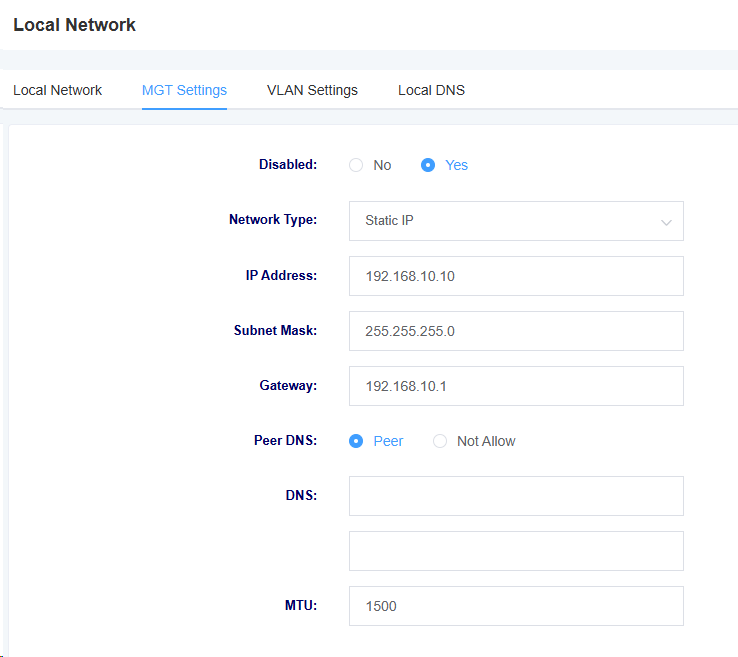
Figure 3-1-2 Management Port Settings Interface
Table 3-1-2 Management Port Settings Interface Parameter Description
| Option | Description |
| Disable | Whether to enable the management port |
| Network Type | Select the network type: DHCP, Static IP, PPPoE |
| IP Address | Set the device’s IP address |
| Subnet Mask | Set the device’s subnet mask |
| Gateway | Set the device’s gateway |
| Peer DNS | Select whether to allow Peer DNS |
| DNS | Set the device’s DNS |
Figure 3-1-3 VLAN Settings Interface
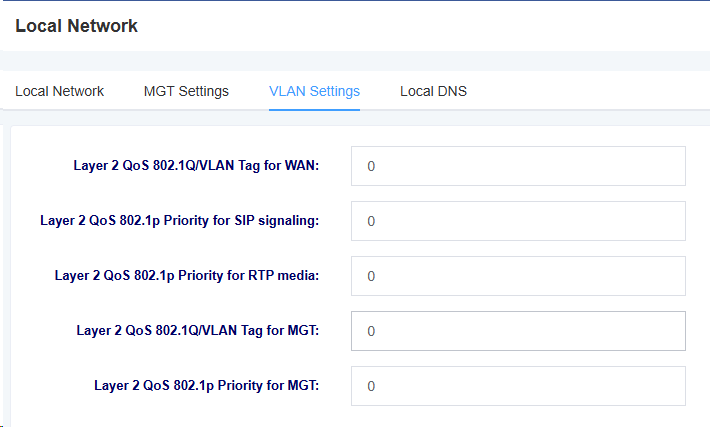
Table 3-1-3 VLAN Settings Interface Parameter Description
| Parameter | Description |
| Layer 2 QoS 802.1Q/VLAN Tag for WAN | Set WAN port tagging |
| Set SIP signaling priority | |
| Set voice priority | |
| Layer 2 QoS 802.1Q/VLAN Tag for MGT | Set management port tagging |
| Set management port priority |
Figure 3-1-5 Add Local DNS Settings Interface
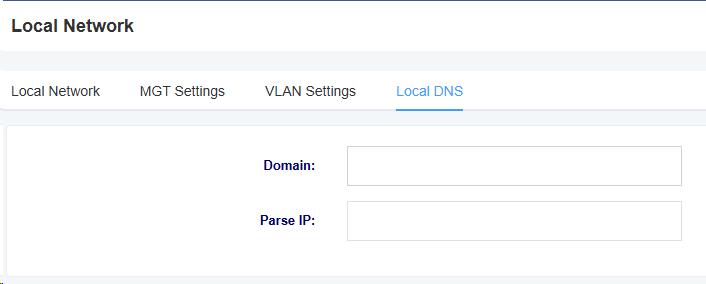
Table 3-1-5 Local DNS Interface Parameter Description
| Option | Description |
| Domain Name | Set device domain name |
| Resolve IP | Set IP to be resolved |
3.2 Static Routing
In the “Static Routing” interface, the network interface, destination IP address, subnet mask, gateway, hop count, and operation for static routing are displayed. You can add static routing here. Click the Add button to add static routing.
Figure 3-2-1 Add Static Routing Interface
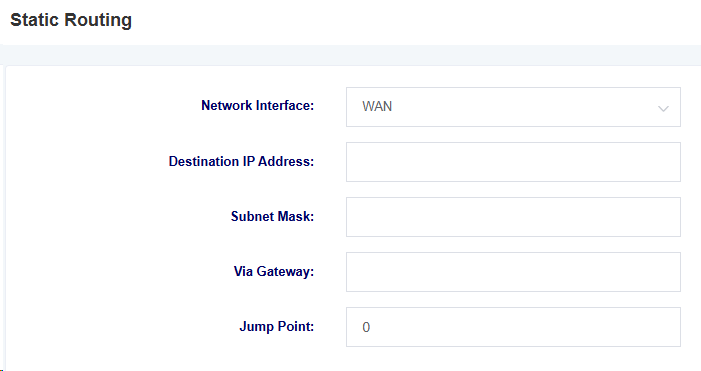
3.3 Firewall
In the “Firewall” page, the firewall rules’ name, protocol, source network domain, source IP, source port, destination network domain, destination IP, destination port, and rule action. You can add firewall rules here to ensure device security. Click the Delete button to delete a firewall rule, and click the Add button to add a firewall rule.
Figure 3-3-1 Firewall Interface
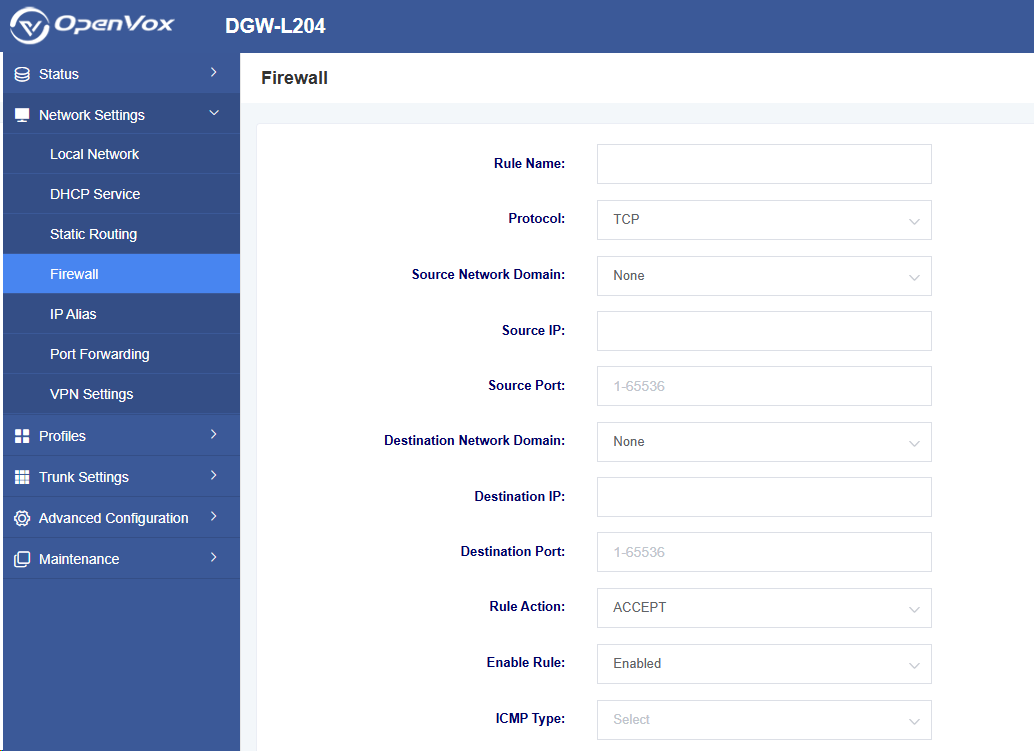
Table 3-3-1 Add Firewall Rule Parameter Description
| Option | Description |
| Rule Name | The name of the firewall rule |
| Protocol | The protocol specified by the firewall rule |
| Source Network Domain | The source network domain of the firewall rule |
| Option | Description |
| Source IP | The source IP defined by the firewall rule. If left blank, it applies to all IP addresses |
| Source Port | Defines the source port, with a range of 1-65535 |
| Destination Network Domain | The destination network domain of the firewall rule |
| Destination IP | The destination IP defined by the firewall rule. If left blank, it applies to all IP addresses |
| Target Port | Define the target port, range: 1-65535 |
| Rule Action | Define the rule action, options: ACCEPT, REJECT, DROP |
3.4 IP Alias
L20X supports setting multiple IP addresses, which can be configured in the IP Alias interface.
Figure 3-4-1 IP Alias Interface
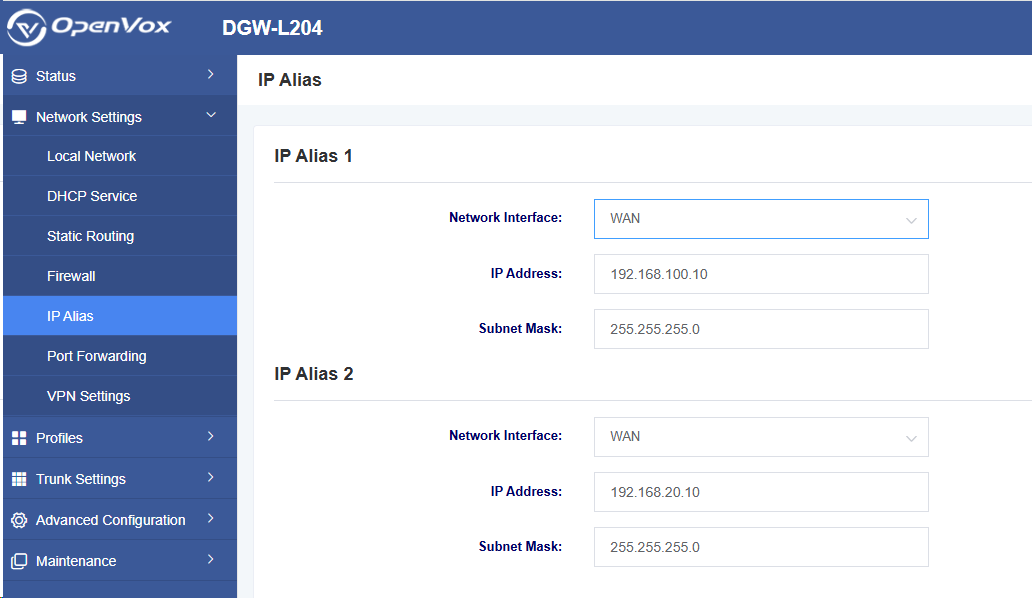
3.5 VPN Settings
Figure 3-5-1 OpenVPN Settings Interface
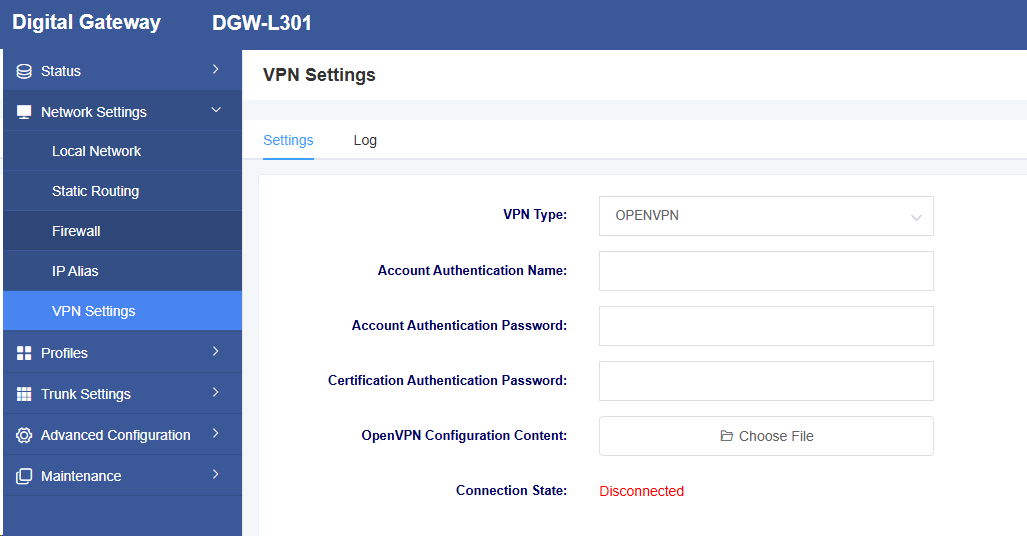
In this interface, you can enable VPN and configure settings. L20X currently supports OpenVPN and Softether VPN.
Table 3-5-1 VPN Settings Description
| Option Description | |
| VPN Type | You can choose to disable VPN or use OpenVPN/Softether VPN |
| Account Authentication Name | The authentication name used by OpenVPN |
| Account Authentication Password | The authentication password used by OpenVPN |
| Cert Authentication Password | The certification authentication password |
| OVPN Configuration Content | Upload the OpenVPN configuration file |
| Connection Status | Display the VPN connection status |
Figure 3-5-2 Softether VPN Settings Interface
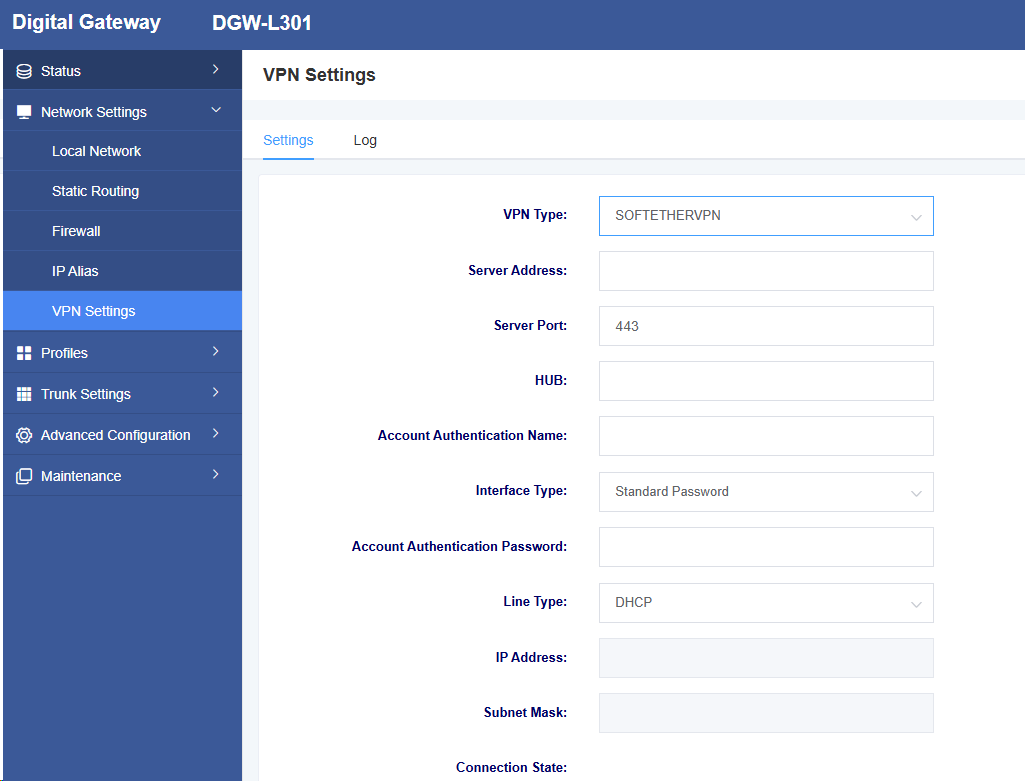
On the Log page, you can select the number of lines to display in the log, then click the Query button. The log will be displayed in the “Log Results” box.
Table 3-5-2 Softether VPN Settings Description
| Option | Description |
| VPN Type | Select to disable VPN or use OpenVPN/Softether VPN |
| Server Address | The server address used by Softether VPN |
| Server Port | The server port used by Softether VPN |
| Hub | Hub Name |
| Option | Description |
| Connection Type | Select standard password or signed certificate |
| Account Verification Password | Enter the password |
| Certificate Cert | Certification Document |
| Certificate Key | Certificate Key |
| Connection Type | Select DHCP or static IP |
| IP Address | Configure IP |
| Subnet Mask | Configure Subnet Mask |
| Connection Status | Display VPN connection status |
4 Profiles
The L20X provides a convenient SIP registration method. Users can easily apply pre-configured templates to SIP trunking. There are four templates available for configuration.
4.1 SIP Settings
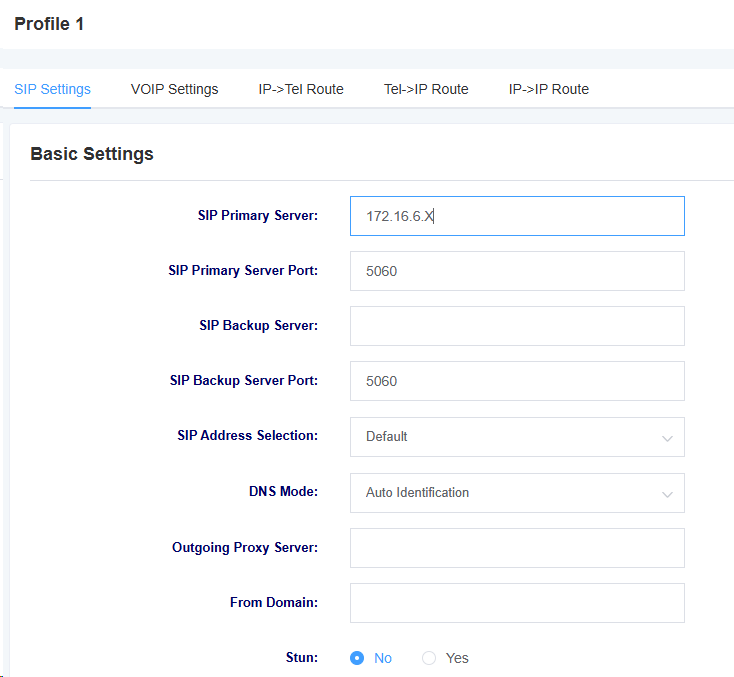
Figure 4-1-1 SIP Settings
Table 4-1-1 SIP Settings Parameter Description
| Option | Description |
| SIP Primary Server | Set the SIP primary server |
| SIP Primary Server Port | Set the SIP primary server port |
| SIP Backup Server | Set the SIP backup server |
| SIP Backup Server Port | Set the SIP backup server port |
| SIP Address Selection | Select which network port the SIP service registers on |
| DNS Mode | Set the DNS mode, with options for automatic or using DNSSRV |
| Outgoing Proxy Server | Set the outbound proxy server; the network will send signaling to this external proxy instead of directly to the peer. |
| From Domain | Set the domain name used to verify the peer |
| Stun | Select whether to enable Stun service |

Figure 4-1-2 SIP Settings
Table 4-1-2 SIP Settings Parameter Description
| Option | Description |
| SIP Transport Method | Set the SIP transport method, with options including UDP, TCP, and TLS |
| Authentication Domain | Set the SIP registration authentication domain |
| Registration Validity Period | Set the registration validity period, default value is 3600 seconds |
| Registration Failure Retry Interval | Set the registration failure retry interval, default value is 30 seconds |
| Registration Failure Retry Times | Set the registration failure retry count, default value is 10 times |
| Disable Qualify Verification | Enable Qualify Verification |
| SIP Heartbeat Sending Frequency | Set SIP Heartbeat Transmission Frequency |
| SIP Heartbeat Timeout | Set SIP Heartbeat Timeout |
| RTP Encryption Mode | Enable RTP Encryption |
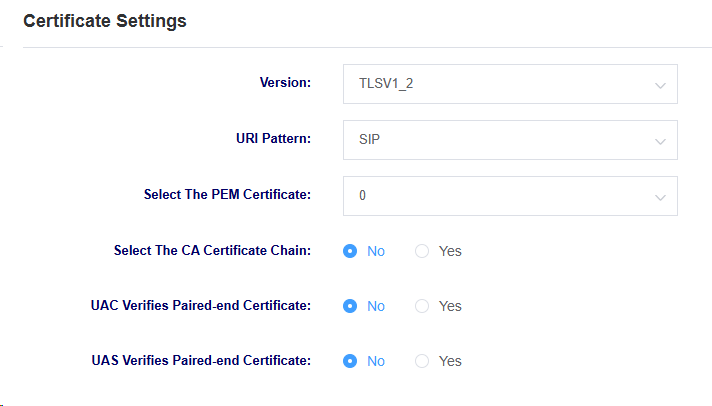
Figure 4-1-3 SIP Settings
| Option | Description |
| Version | Select the certificate version. The device supports different versions of TLS, SSL, and SSH certificates. |
| URI Mode | Select the URI mode. Supports SIP and SIPS. |
| Select The PEM Certificate | Select the device PEM certificate. |
| SelectThe CA Certificate Chain | Select whether to enable the CA certificate chain. |
| UAC Verifies Paired-end Certificate | As the calling party, select UAC to use the phone as the authenticator. Or select UAS to use the called party or proxy server as the authenticator. |
| UAS Verifies Paired-end Certificate | As the called party, select UAC to use the called party or proxy server as the authenticator, or select UAS to use the phone as the authenticator. |
4.2 VOIP Settings
On this screen, users can set VOIP-related parameters.
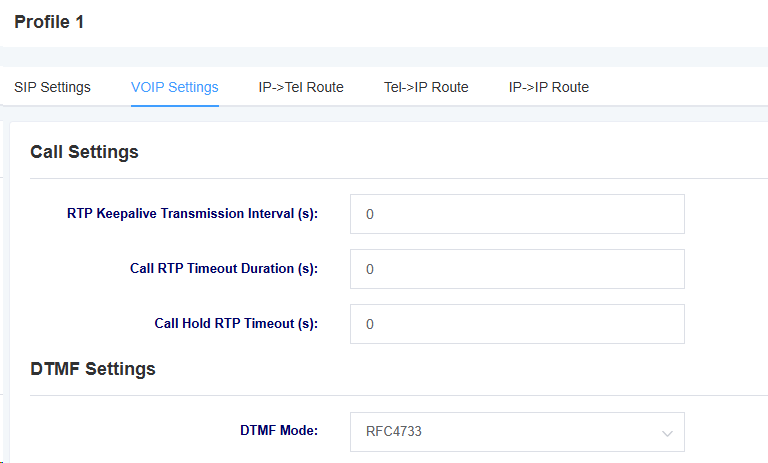
Figure 4-2-1 VOIP Settings
Table 4-2-1 VOIP Settings Parameter Description
| Option | Description |
| RTP Keepalive Transmission Interval (s) | Set the RTP keepalive send interval |
| Call RTP Timeout Duration | Set the call RTP timeout |
| Call Hold RTP Timeout | Set the call hold RTP timeout |
| DTMF Mode | Set the DTMF mode, with options including RFC4733, inband, info, auto, and auto_info |
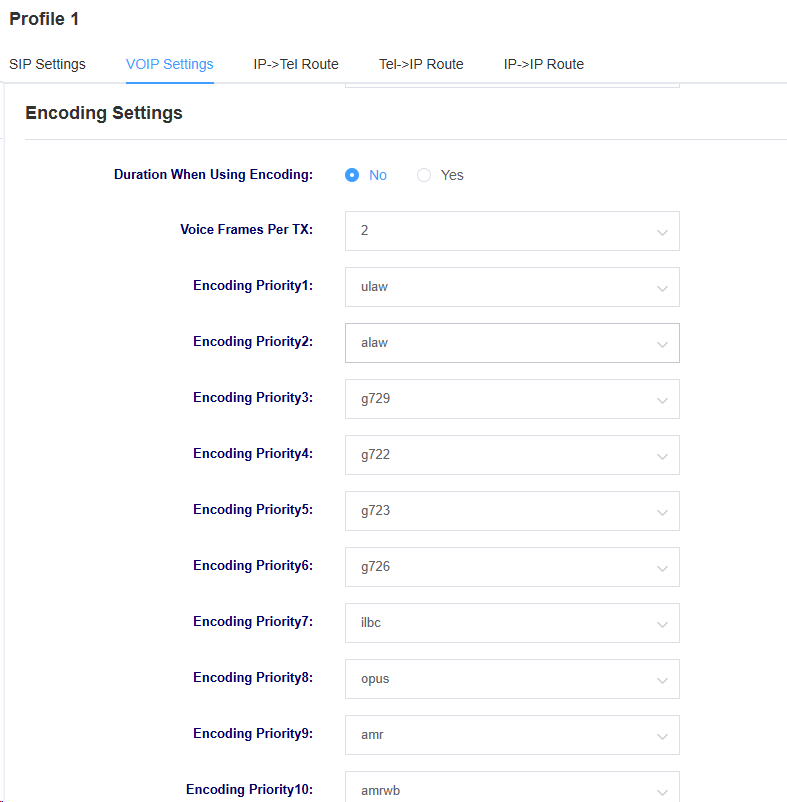
Figure 4-2-2 VOIP Settings
Table 4-2-2 VOIP Settings Parameter Description
| Option | Description |
| Duration When Using Encoding | Select whether to use duration When Using Encoding |
| Encoding Priority | Set the encoding priority |
| Enable UDPTL | Select whether to enable UDPTL |
| UDPTL Error Correction | Select UDPTL Error Correction Method |
4.3 IP->Tel Routing
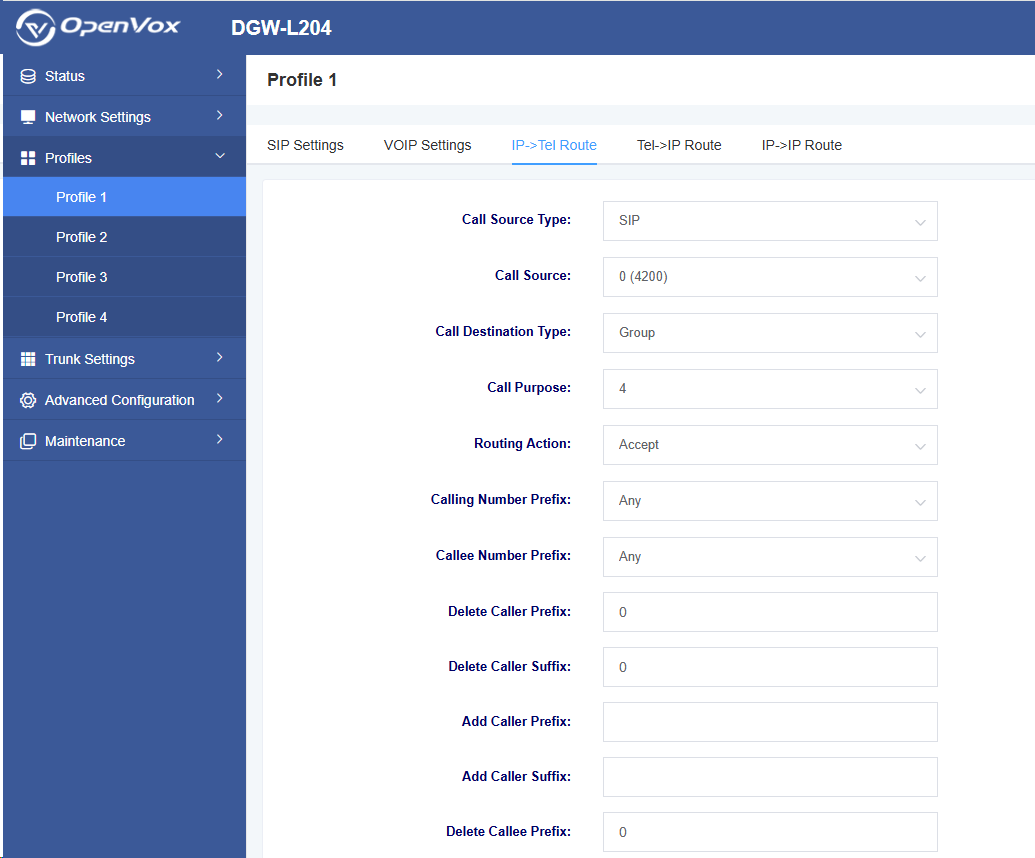
Figure 4-3-1 IP->TEL Routing
You can set the relevant routing on this page.
Table 4-3-1 IP->TEL Routing Parameter Description
| Option | Description |
| Routing Failed Call Destination | The destination to which the call is sent when the call fails |
| Call Source Type | Type of call source device |
| Call Source | Call source device |
| Call Destination Type | Destination type |
| Call Purpose | Call Purpose |
| Routing Action | Reject or Allow |
| Calling Number Prefix | Set caller ID prefix type |
| Callee Number Prefix | Set called ID prefix type |
| Delete caller prefix | Delete caller ID prefix |
| Delete Caller Suffix | Delete called ID prefix |
| Add caller prefix | Add caller ID prefix |
| Add caller suffix | Add Caller Suffix |
| Delete Callee Prefix | Delete Called Prefix |
| Delete Callee Suffix | Delete Called Suffix |
| Add Callee Prefix | Add Called Prefix |
| Add Callee Suffix | Add Called Suffix |
4.4 TEL->IP Routing
Figure 4-4-1 TEL->IP Routing
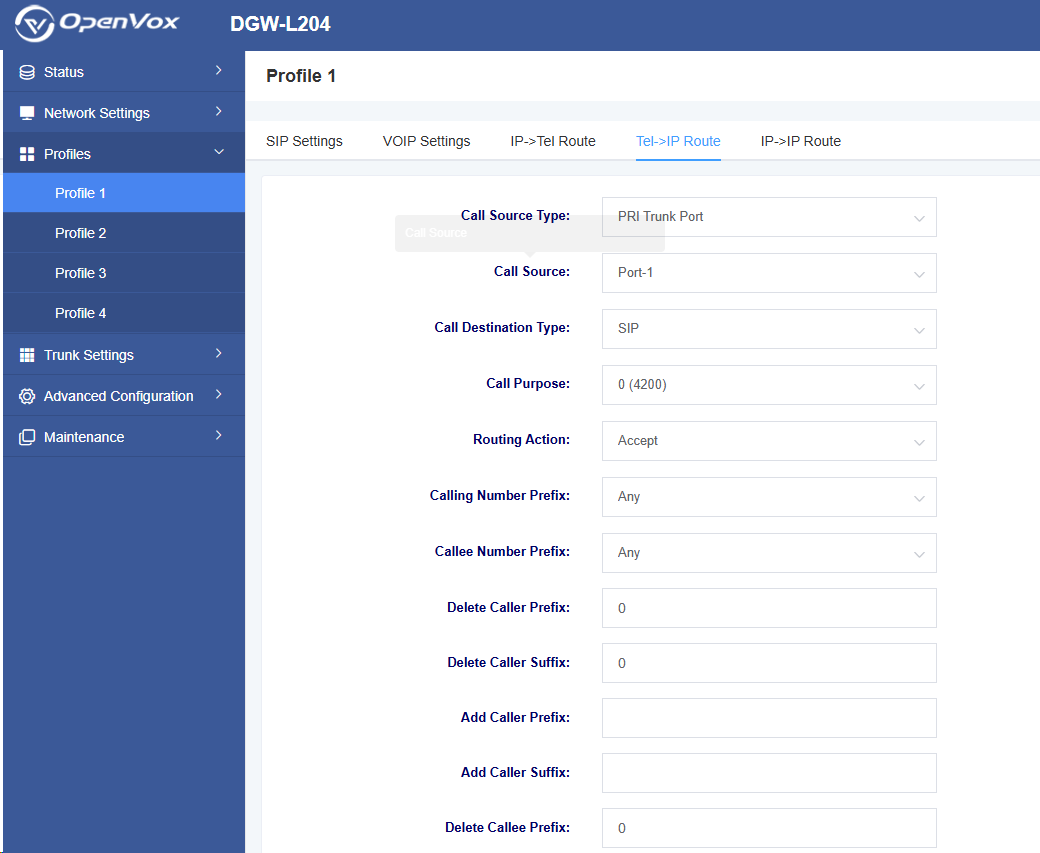
On this page, you can configure related routes.
Table 4-4-1 TEL->IP Routing Parameter Description
| Option | Description |
| Routing Failed Call Destination | The destination to which the call is redirected when the call fails |
| Call Source Type | The type of the call source device |
| Call Source | Calling source device |
| Calling destination type | Destination type |
| Calling Purpose | Calling purpose |
| Routing action | Reject or allow |
| Calling number prefix | Set calling number prefix type |
| Callee number prefix | Set called number prefix type |
| Delete caller prefix | Delete calling number prefix |
| Delete caller Suffix | Delete called number suffix |
| Option | Description |
| Add caller prefix | Add calling number prefix |
| Add caller suffix | Add Caller Suffix |
| Delete Callee Prefix | Delete Called Prefix |
| Delete Callee Suffix | Delete Called Suffix |
| Add Callee Prefix | Add Called Prefix |
| Add Callee Suffix | Add Called Suffix |
4.5 IP->IP Routing
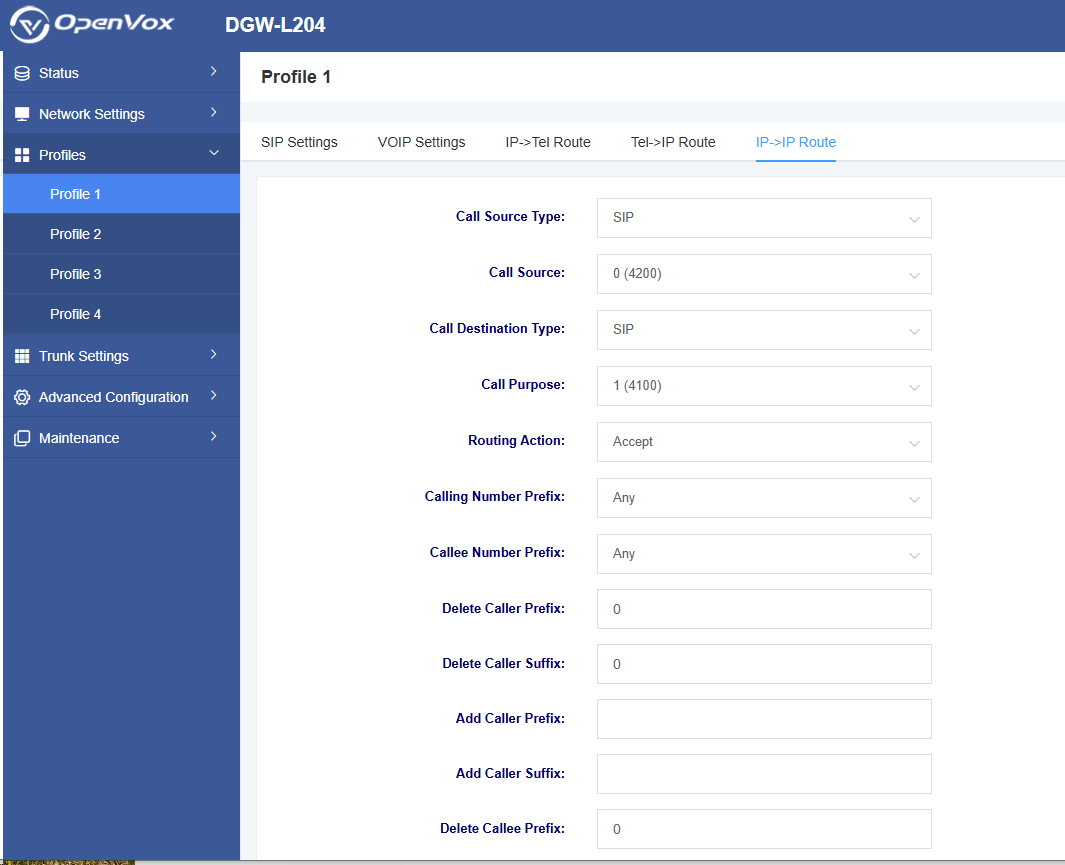
Figure 4-5-1 IP->IP Routing
On this page, you can configure related routing settings.
Table 4-5-1 IP->IP Routing Parameter Description
| Option | Description |
| Routing Failed Call Destination Type | Whether to enable routing failed call destination type: |
| Routing Failed Call Destination | The destination to which the call is redirected when the call fails |
| Call Source Type | The type of the call source device |
| Call Source | The call source device |
| Call Destination Type | Destination type |
| Call Purpose | Call Purpose |
| Routing Action | Reject or allow |
| Option | Description |
| Calling Number Prefix | Set the type of caller ID prefix |
| Callee NumberPrefix | Set the type of called ID prefix |
| Delete caller prefix | Delete caller number prefix |
| Delete Caller Suffix | Delete caller number suffix |
| Add caller prefix | Add caller number prefix |
| Add caller suffix | Add caller number suffix |
| Delete callee prefix | Delete called number prefix |
| Delete callee suffix | Delete called party number suffix |
| Add callee prefix | Add called party number prefix |
| Add callee suffix | Add called party number suffix |
5 Trunk settings
On this page, you can configure trunk type settings.
5.1 SIP trunk
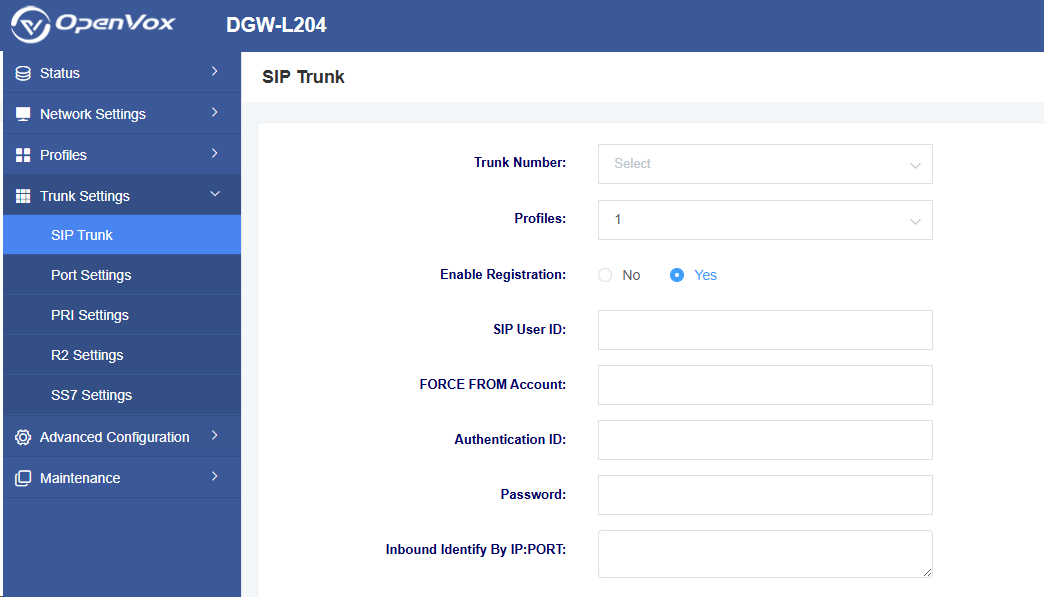
Figure 5-1-1 Add SIP trunk page
Table 5-1-1 SIP trunk page parameter description
| Option | Description |
| Trunk number | Customize trunk number |
| Profiles | Select the template settings to use |
| Enable registration | Select whether to enable registration settings |
| SIP User ID | Set the trunk name |
| FORCE FROM Account | Set the FROM mandatory account |
| Authentication ID | The authentication ID corresponding to this SIP user ID |
| Password | The password corresponding to the authentication ID |
| Set the caller display name |
5.2 Port Settings
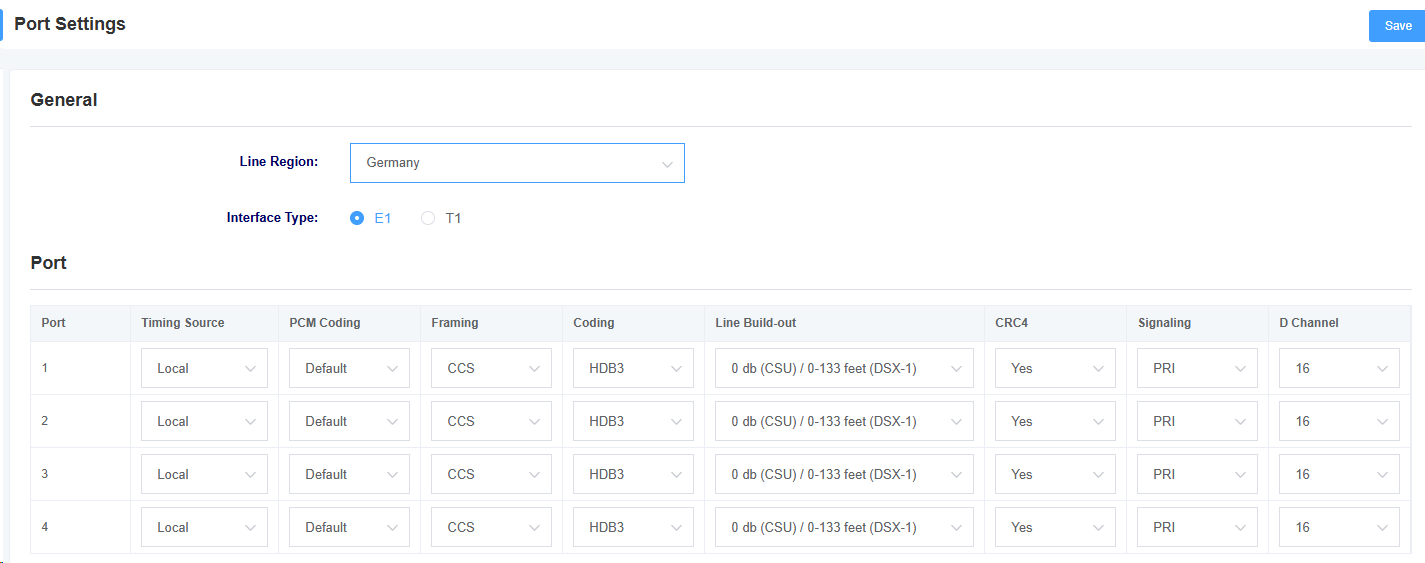
Figure 5-2-1 Port Settings
Table 5-2-1 Call Settings Parameter Description
| Option | Description |
| Line Region | Set the line area |
| Interface Type | E1 or T1 type |
| Timing Source | Select the timing source |
| PCM Coding | Select Encoding Format |
| Option | Description |
| Frameing | Frame Structure Type |
| Coding | Select Line Encoding |
| Line Build-out | External line represents the cable length from this network port to the next device. |
| CRC4 | Set the checksum |
| Signaling | Set the signaling type |
| D Channel | Set the D channel position |
5.3 PRI Settings

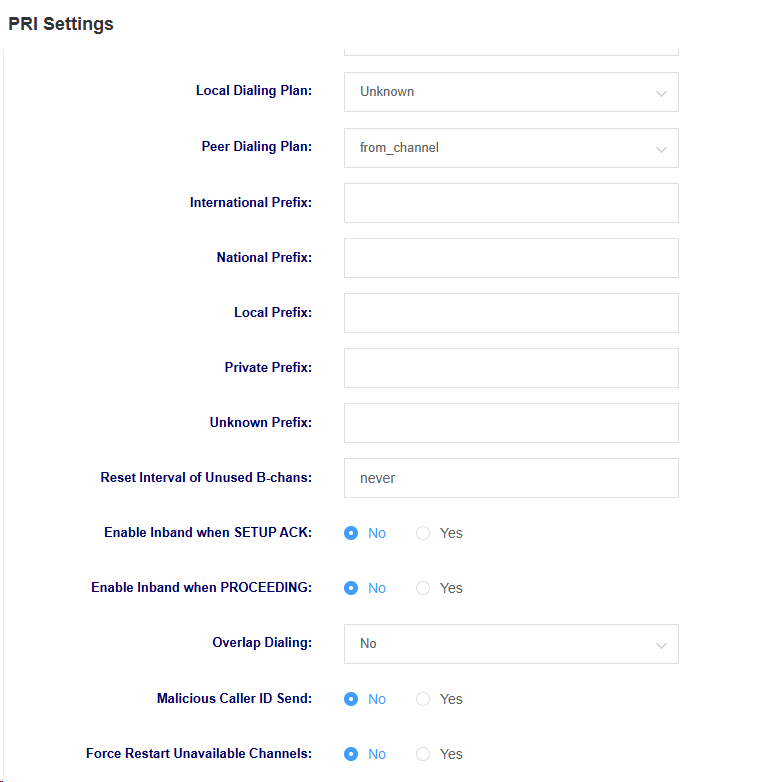
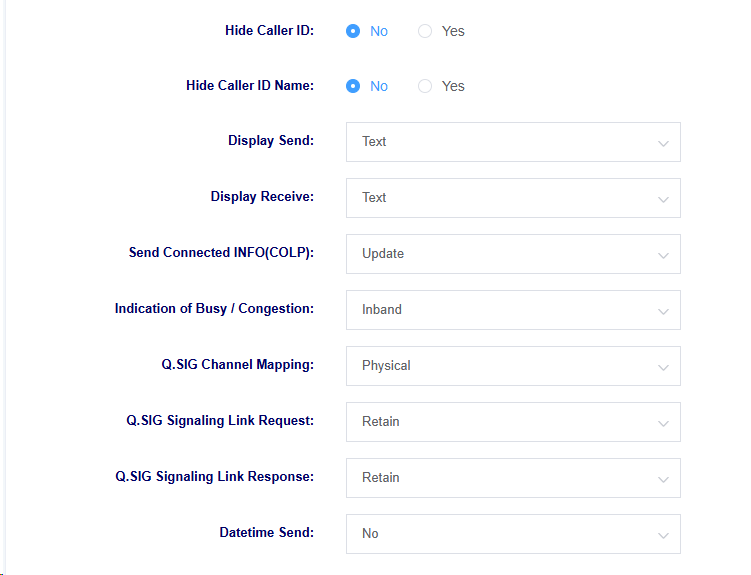
Figure 5-3-1 PRI Settings
Table 5-3-1 Call Settings Parameter Description
| Option | Description |
| Port | Select the port |
| Enable | Whether to enable |
| Signaling Type | Set signaling type |
| Switching Type | Switching type for digital signaling |
| Group | Set group number |
| Profiles | Select profilesto use |
| Echo Cancellation | Echo cancellation length |
| RX Gain | Receive signal gain |
| TX Gain | Transmit signal gain |
| ATT Operator Network Special Parameters | |
| Service Message Support | Enable Message Service Support |
| Dialing Plan | Dialing Plan |
| Option | Description |
| Local Dialing Plan | Local Dialing Plan |
| Remote Dialing Plan | Remote Dialing Plan |
| International Prefix | Number prefix international |
| National Prefix | National Prefix |
| Local Prefix | Local prefix |
| Private Prefix | Private prefix |
| Prefix unknown | Prefix unknown |
| Enable Inband when SETUP ACK | Whether to enable inband when SETUP ACK |
| Enable Inband when PROCEEDING | Whether to enable Inband when PROCEEDING |
| Overlap dialing | Overlap dialing |
| Malicious Caller ID Send | Whether to set malicious Caller ID Send |
| Force Restart Unavailable Channels | Whether to force Restart Unavailable Channels |
| Hide caller ID | Whether to hide caller ID |
| Hide Caller ID Name | Whether to hide caller name |
| Display Send | Send display Note: Only NET side supports, CPE and Q.SIG do not support |
| Display Receive | Receive display Note: Only NET side supports, CPE and Q.SIG do not support |
| Send Connected INFO(COLP) | Whether to send connected INFO(COLP) |
| PRI busy and congestion indication method | |
| Q.SIG channel Mapping | Set Q.SIG channel mapping method Note: T1 forces physical |
| Q.SIG Signaling Link Request | Set Q.SIG call signaling link |
| Q.SIG Signaling Link Response | Set Q.SIG Response Signaling Link |
| Datetime Send | Set NET Side Sends Datetime to CPE Side |
5.4 R2 Settings

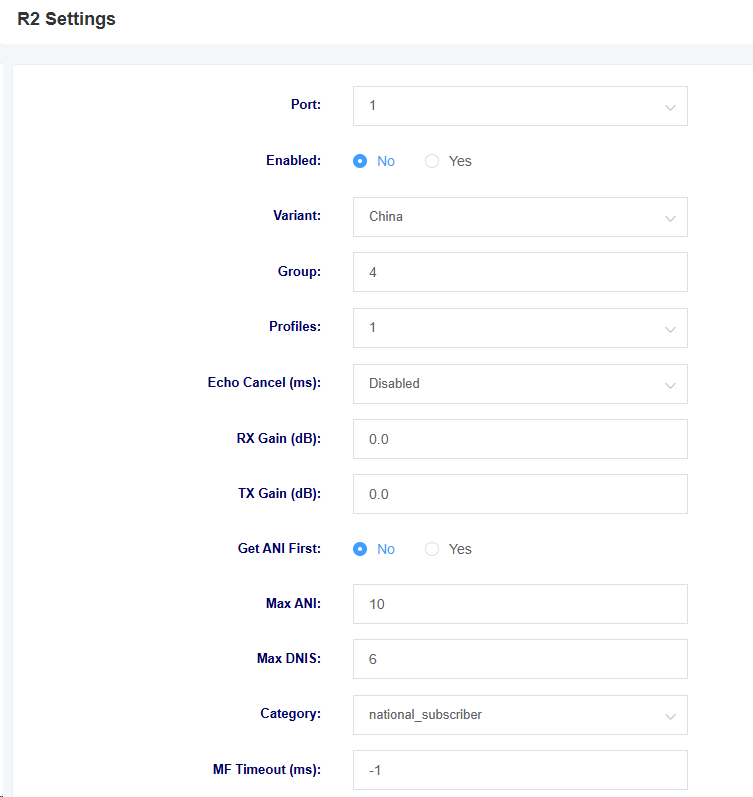
Figure 5-4-1 R2 Settings
| Parameters | Description |
| Port | Select Port |
| Enable | Whether to enable the port |
| Variant | Select the variant type |
| Group | Set grouping |
| Profiles | Select the profiles to use |
| Parameter | Description |
| Echo Cancellation | Enable echo cancellation |
| RX Gain | Set receive gain |
| Tx Gain | Set transmit gain |
|
|
Get ANI before obtaining DNIS |
| Maximum ANI | Maximum ANI digits requested |
| Maximum DNIS | Maximum DNIS digits requested |
| Category | Set category |
| MF Timeout | MF timeout duration |
| Metering Pulse Timeout (ms) | Pulse timeout duration |
| Skip Category | Skip requesting caller category and ANI |
| Dual Answer | Whether to support dual answer |
5.5 SS7 Settings

Figure 5-5-1 SS7 Settings
Table 5-5-1 SS7 Parameter Description
| Parameter | Description |
| Link Set | Select link group |
| Signaling Channel | Signaling channel |
| Voice Channel | Audio Channel |
| Start Circuit Identification Code | CIC Start Bit |
| Echo Cancellation | Echo Cancellation Switch |
| Echo Cancellation Training | Echo Training Period |
| Echo Cancellation Taps | Echo Cancellation TAPS (ms = taps/8) |
| RX Gain | Receive Energy Gain |
| TX Gain | Transmit Energy Gain |
6 Advanced Configuration
6.1 Fax Parameters
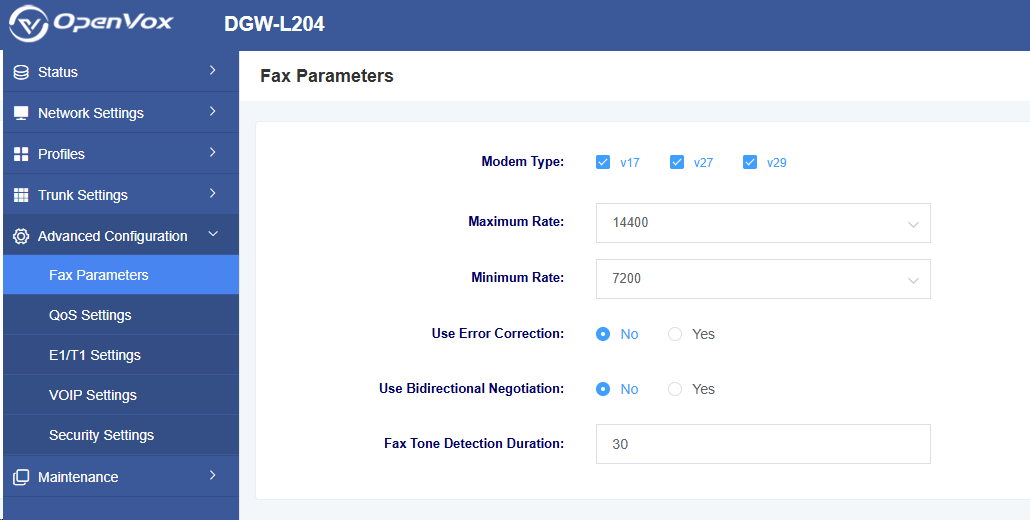
Figure 6-1-1 Fax Parameters
On this page, you can configure fax-related parameters.
Table 6-1-1 Network Settings Description
| Option | Description |
| Modem Type | Set the supported modem type |
| Maximum Rate | Select the maximum rate supported by the fax |
| Minimum Rate | Select the minimum rate supported by the fax |
| Use Error Correction | Select whether to enable error checking |
| Use Bidirectional Negotiation | Select whether to enable bidirectional negotiation |
| Fax Tone Detection Duration | Set the fax tone detection duration |
6.2 QoS Settings
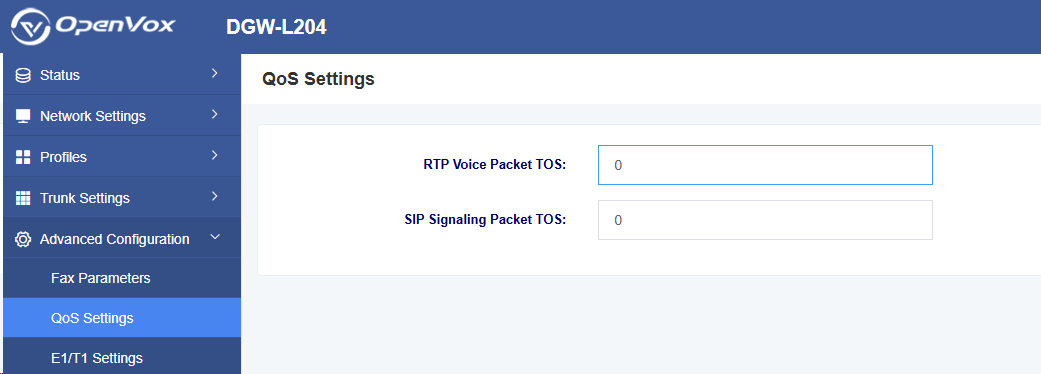
Figure 6-2-1 QoS Settings Interface
In this interface, you can set the RTP voice message TOS and SIP signaling message TOS.
6.3 E1/T1 Settings
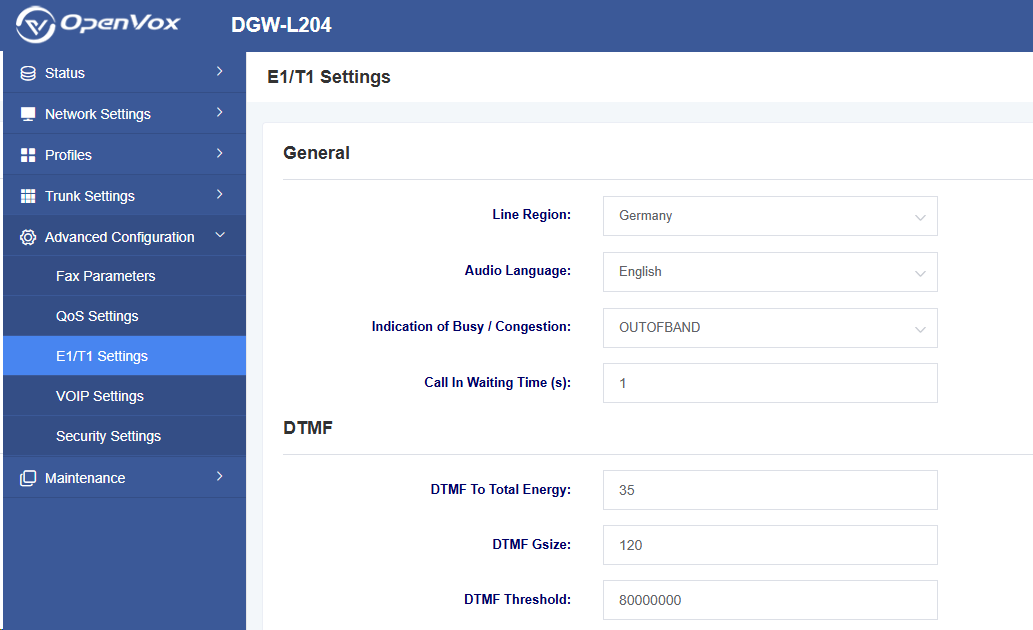
Figure 6-3-1 E1/T1 Settings Interface
In this interface, you can set parameters related to digital lines, such as DTMF and jitter buffer.
Table 6-3-1 E1/T1 Parameter Description
| Option | Description |
| Line Region | Select the region where the line is located |
| Audio Language | Select the language for voice prompts |
| Indication of Busy / Congestion | Select the mode for generating BUSY and CONGESTION notifications |
| DTMF To Total Energy | Adjust the energy ratio coefficient |
| DTMF Gsize | Set the DTMF gsize |
| DTMF Threshold | Set the DTMF Threshold |
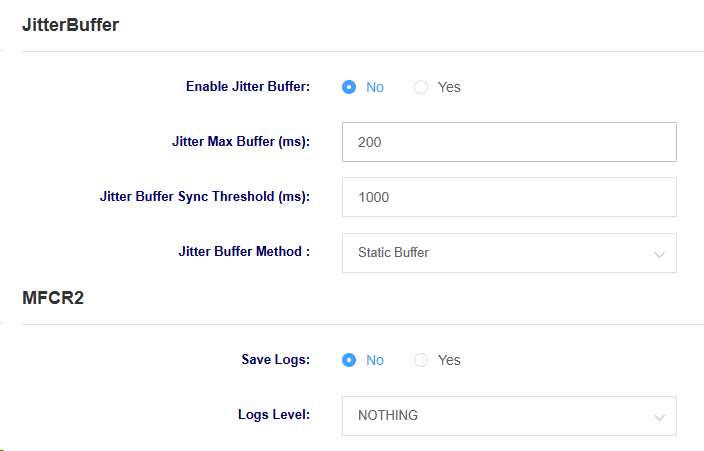
Figure 6-3-2 E1/T1 Settings Interface
Table 6-3-2 E1/T1 Settings Parameter Description
| Option | Description |
| Enable Jitter Buffer | Select whether to enable the jitter buffer |
| Jitter Buffer Mode | Select jitter buffer mode |
| Jitter Buffer Sync Threshold (ms) | Set Jitter Buffer Sync Threshold (ms) |
| Maximum jitter buffer | Set maximum jitter buffer |
| Save Logs | Logging enabled |
6.4 VOIP Settings
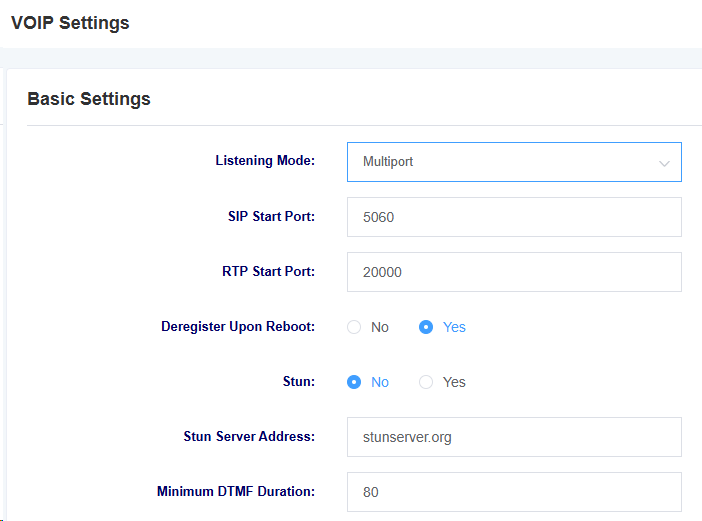
Figure 6-4-1 VOIP Settings
On this page, you can configure VOIP-related settings, such as call settings and session settings.
Table 6-4-1 VOIP Settings Parameter Description
| Option | Description |
| Listening Mode | Select listening mode, with options for multi-port and single-port |
| SIP Start Port | Set the SIP start port |
| RTP Start Port | Set the RTP start port |
| Unregister on Reboot | Select whether to unregister on reboot |
| STUN | Select whether to enable STUN |
| STUN Server Address | Set the STUN server address |
| Minimum DTMF duration | Set the minimum DTMF duration |
Figure 6-4-2 VoIP settings

Table 6-4-2 VoIP settings parameter description
| Option | Description |
| T1 timeout | Set the T1 timeout duration |
| T2 timeout | Set the T2 timeout duration |
| Incoming Call Wait Timeout (s) | Set the call waiting timeout duration |
| Outgoing Call Waiting timeout | Set the outgoing call waiting timeout duration |
| Maximum Call Time Limit (ms) | Set the maximum call times; calls will be disconnected after exceeding this limit |
| Outgoing Caller ID Priority | Select whether to prioritize displaying the caller ID from the FROM field or the P-Asserted-Identity field |
| User Agent | Set User Agent |
| Do not escape the “#” symbol | Whether to not escape the # symbol |
Figure 6-4-3 VoIP Settings

Table 6-4-3 VoIP Settings Parameter Description
| Option | Description |
| Session Timer Mode | Select session timer mode |
| Min-SE | Set minimum session timeout |
| Session Timeout | Set the session timeout duration |
| G723 Rate | Set the G723 rate |
| iLBC Frame Size | Set the iLBC frame duration |
6.5 Security Settings
Certificates can be uploaded on this page.

Figure 6-5-1 Security Settings Interface
7 Maintenance
7.1 Automatic restart
On this page, you can set the automatic restart function, and the device will restart according to the set time.

Figure 7-1-1 Restart page

Figure 7-2-1 Automatic restart page
7.2 Restore factory settings
After clicking the Restore Factory Settings button, the device will automatically restart and restore the factory settings.

Figure 7-2-1 Restore Factory Settings Interface
7.3 Automatic Deployment
L20X configuration files and upgrade files functionality can be configured on this page.
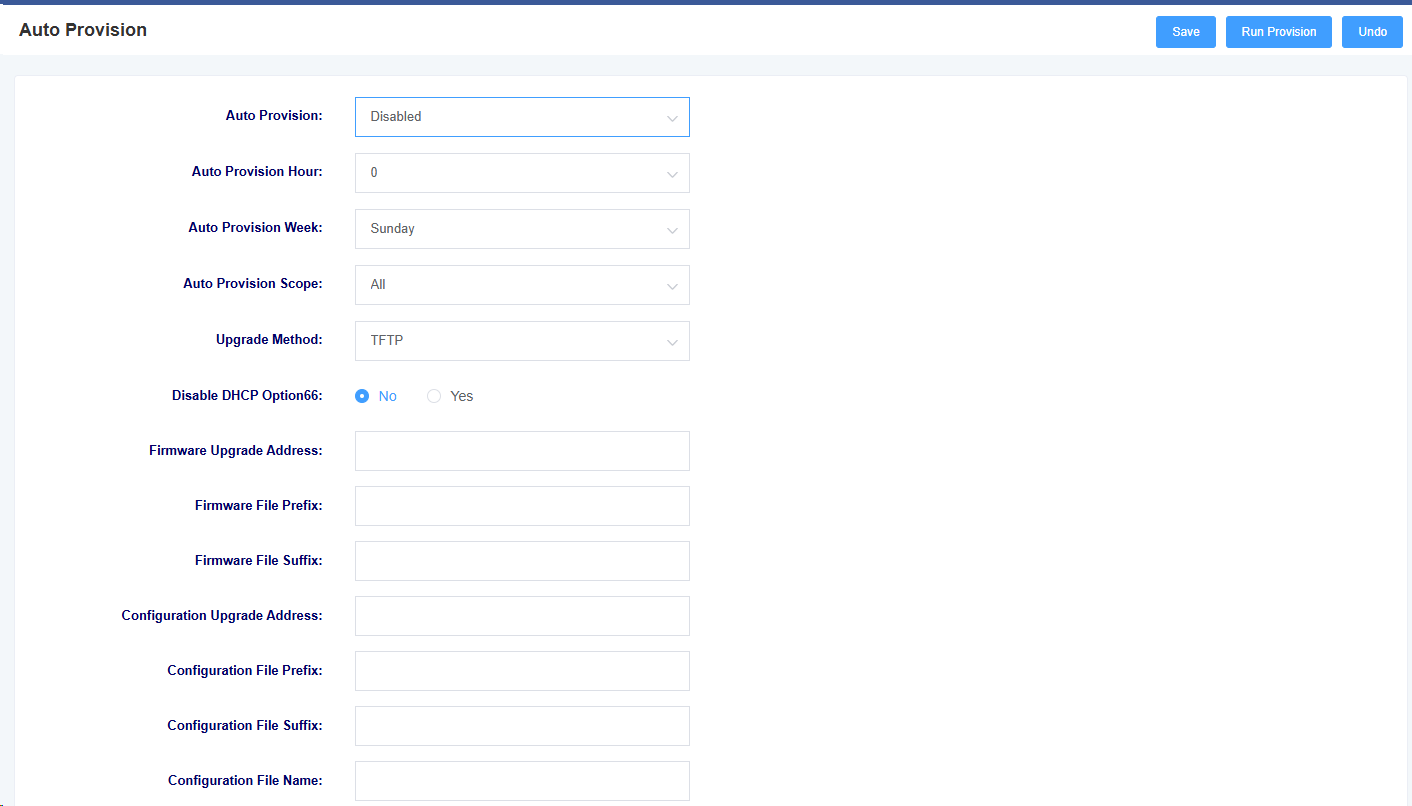
Figure 7-3-1 Automatic Deployment Interface

Table 7-3-1 Automatic Deployment Parameter Description
| Option | Description |
| Automatic Deployment | Set the automatic deployment mechanism. You can choose to deploy automatically after each power-on or deploy according to a set time cycle. |
| Automatic Deployment Hour | Set the time for deployment. |
| Automatic Deployment Week | Set the day of the week for deployment. |
| Option | Description |
| Automatic Provision Scope | Select the scope of automatic deployment, with options for configuration files and firmware upgrades |
| Upgrade Method | Select the automatic deployment upgrade method, supporting TFTP, HTTP, and HTTPS |
| Disable DHCP Option 66 | Select whether to enable DHCP Option 66 for file retrieval |
| Option | Description |
| Firmware Upgrade Address | Set the firmware upgrade path |
| Firmware File Prefix | Set the firmware file prefix |
| Firmware File Suffix | Set the firmware file suffix |
| Configuration Upgrade Address | Set the configuration upgrade path |
| Configuration File Prefix | Set the prefix for configuration files |
| Configuration file suffix | Set the suffix for configuration files |
| Configuration File Name | Set the configuration file name |
| Upload configuration | Upload configuration files |
| Download configuration | Download the current configuration files for the device |
File names must be modified according to the rules. The main controller firmware file name rule is (pre)(firmware model).img(post), and the interface board firmware file name rule is
(pre)ixu(mac).img(post), and the configuration file name rule is (pre)cfg(mac)(post). “pre” is the prefix, and “post” is the suffix; both can be left blank.
7.4 Firmware upgrade
On this page, you can perform firmware upgrades. Select the corresponding firmware type and upload the file to proceed with the upgrade. You can choose whether to retain the system configuration. If the system configuration is not retained, the device will clear the system configuration after the upgrade.
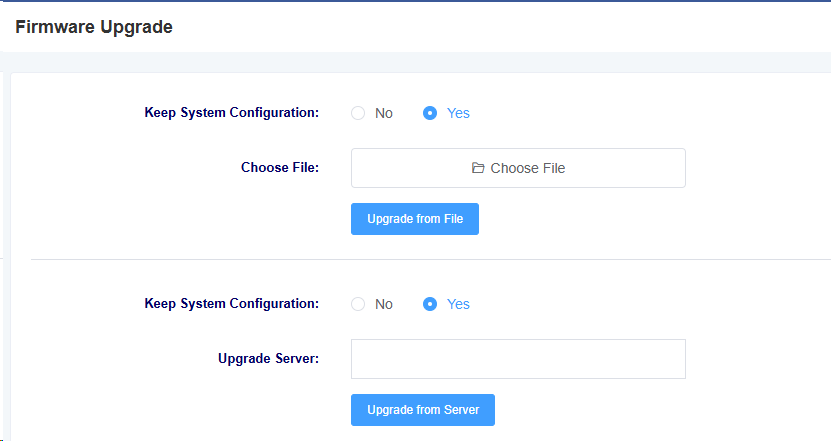
Figure 7-4-1 Firmware Upgrade
7.5 Time Settings
On this page, you can configure the device’s time settings. Users can set the time zone and specify the NTP server address for automatic time synchronization.

Figure 7-5-1 Time Settings
Table 7-5-1 Time Settings Parameter Description
| Option | Description |
| Time Zone | Set the device’s time zone |
| System Time | Display the system time |
| Enable NTP Time Synchronization | Select whether to enable NTP time synchronization |
| NTP Server Address | Set the NTP server address |
7.6 User Management
The L20X supports different user roles for login, with varying permissions. In the User Management page, you can modify passwords, enable/disable SSH functionality, and configure HTTP settings for different roles.
Figure 7-6-1 User Management
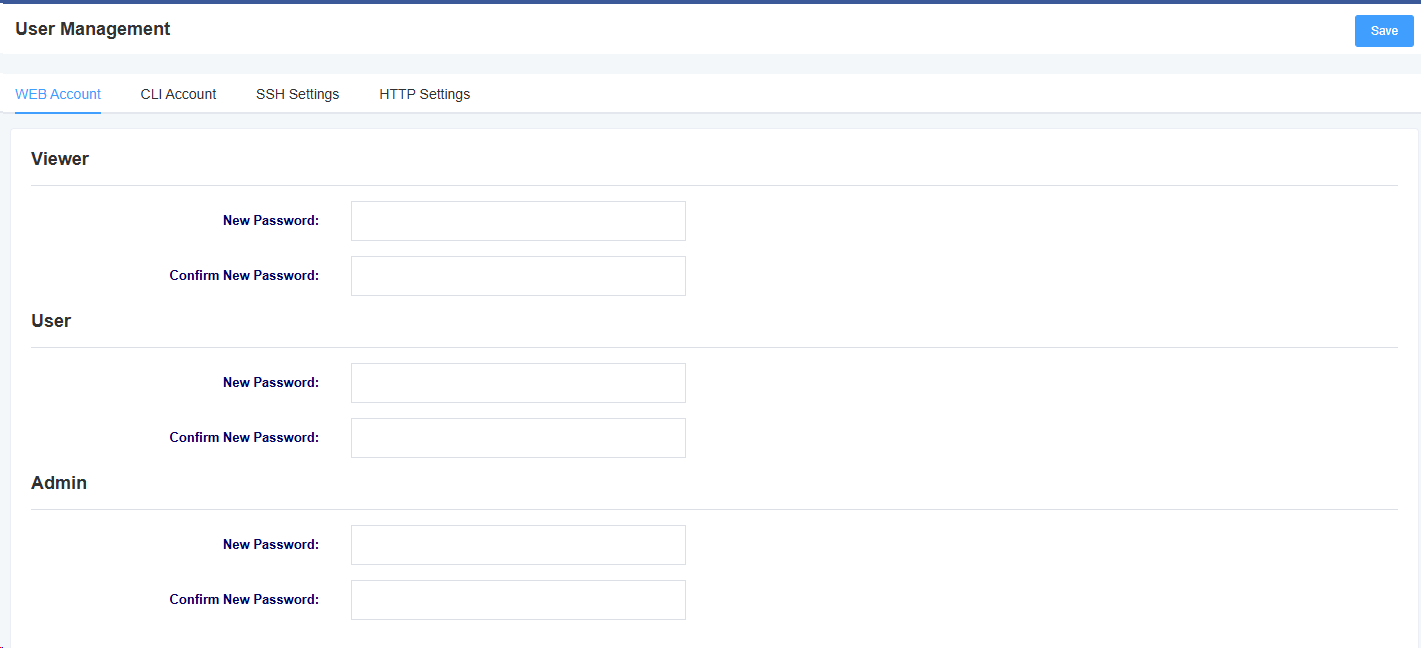


7.7 Network Packet Capture
L20X can help locate network issues. Users can define the capture interface, select protocol types, addresses, and ports in this interface.
Figure 7-7-1 Network Packet Capture
7.8 Signaling Packet Capture
The L20X can perform signaling packet capture.

Figure 7-8-1 Signaling Packet Capture
7.9 Log Management
In the log management interface, you can set the log server address and port, as well as select the kernel log level, to facilitate technical analysis of device logs.
Figure 7-9-1 Log Management

Figure 7-9-2 Supported Log Interface

Syslog is commonly referred to as system logs or system records, and is a standard used to transmit log messages over a TCP/IP network. This term is often used to refer to the actual syslog protocol or the applications or databases that send syslog messages. The syslog protocol is a master-slave protocol: the syslog sender transmits a small text message (less than 1024 bytes) to the syslog receiver. The receiver is typically named “syslogd,” “syslog daemon,” or syslog server. System log messages can be transmitted using the UDP protocol and/or the TCP protocol.
Syslog Level Overview:
-
-
- EMERG: Failure
- ALERT: Warning
- CRIT: Requires immediate attention
- ERROR Error conditions that prevent the tool or certain subsystem functions from being implemented
- WARNING Warning information
- NOTICE Important general conditions
- INFO Information
- DEBUG Other information that does not contain function conditions or issues
-
7.10 SNMP
In this section, you can configure SNMP service-related information. L20X supports SNMPv1, v2c.
Figure 7-10-1 SNMP
7.11 Cloud Management
On this page, you can configure information related to cloud management. L20X supports Openvox’s cloud management functionality. After entering the server address port and binding code, you can manage the device on the cloud management platform.
Figure 7-11-1 Cloud Management Settings

Figure 7-11-2 Cloud Management Binding

7.12 UPnP
On this page, you can choose whether to enable the UPnP function. Once enabled, the server can automatically search for local devices for management.
Figure 7-12-1 UPnP Settings

7.13 Whitelist
Figure 7-13-1 Whitelist Settings

On this page, you can set whitelist-related information. After setting, only IP addresses in the whitelist can access the device.
7.14 Ping Test
Figure 7-14-1 Ping Test

On this page, you can use the ping command to test network connectivity.
7.15 Tracert Test
On this page, you can use the tracert command to test network connectivity.
Figure 7-15-1 Tracert Test

7.16 DNS Test
Figure 7-16-1 DNS Test

7.17 Port Listening
On this page, you can select a specific port for logging to troubleshoot
Figure 7-17-1 Port Listening


